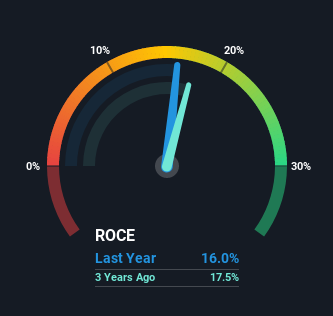Stock Analysis
- United States
- /
- Consumer Durables
- /
- NYSE:LZB
Returns On Capital At La-Z-Boy (NYSE:LZB) Have Hit The Brakes

What are the early trends we should look for to identify a stock that could multiply in value over the long term? One common approach is to try and find a company with returns on capital employed (ROCE) that are increasing, in conjunction with a growing amount of capital employed. Ultimately, this demonstrates that it's a business that is reinvesting profits at increasing rates of return. With that in mind, the ROCE of La-Z-Boy (NYSE:LZB) looks decent, right now, so lets see what the trend of returns can tell us.
Understanding Return On Capital Employed (ROCE)
For those who don't know, ROCE is a measure of a company's yearly pre-tax profit (its return), relative to the capital employed in the business. Analysts use this formula to calculate it for La-Z-Boy:
Return on Capital Employed = Earnings Before Interest and Tax (EBIT) ÷ (Total Assets - Current Liabilities)
0.16 = US$187m ÷ (US$1.9b - US$681m) (Based on the trailing twelve months to October 2021).
So, La-Z-Boy has an ROCE of 16%. That's a relatively normal return on capital, and it's around the 15% generated by the Consumer Durables industry.
See our latest analysis for La-Z-Boy

In the above chart we have measured La-Z-Boy's prior ROCE against its prior performance, but the future is arguably more important. If you'd like to see what analysts are forecasting going forward, you should check out our free report for La-Z-Boy.
What Does the ROCE Trend For La-Z-Boy Tell Us?
While the current returns on capital are decent, they haven't changed much. Over the past five years, ROCE has remained relatively flat at around 16% and the business has deployed 78% more capital into its operations. Since 16% is a moderate ROCE though, it's good to see a business can continue to reinvest at these decent rates of return. Stable returns in this ballpark can be unexciting, but if they can be maintained over the long run, they often provide nice rewards to shareholders.
On another note, while the change in ROCE trend might not scream for attention, it's interesting that the current liabilities have actually gone up over the last five years. This is intriguing because if current liabilities hadn't increased to 37% of total assets, this reported ROCE would probably be less than16% because total capital employed would be higher.The 16% ROCE could be even lower if current liabilities weren't 37% of total assets, because the the formula would show a larger base of total capital employed. With that in mind, just be wary if this ratio increases in the future, because if it gets particularly high, this brings with it some new elements of risk.
What We Can Learn From La-Z-Boy's ROCE
To sum it up, La-Z-Boy has simply been reinvesting capital steadily, at those decent rates of return. And given the stock has only risen 22% over the last five years, we'd suspect the market is beginning to recognize these trends. So because of the trends we're seeing, we'd recommend looking further into this stock to see if it has the makings of a multi-bagger.
On a separate note, we've found 1 warning sign for La-Z-Boy you'll probably want to know about.
For those who like to invest in solid companies, check out this free list of companies with solid balance sheets and high returns on equity.
Valuation is complex, but we're helping make it simple.
Find out whether La-Z-Boy is potentially over or undervalued by checking out our comprehensive analysis, which includes fair value estimates, risks and warnings, dividends, insider transactions and financial health.
View the Free AnalysisHave feedback on this article? Concerned about the content? Get in touch with us directly. Alternatively, email editorial-team (at) simplywallst.com.
This article by Simply Wall St is general in nature. We provide commentary based on historical data and analyst forecasts only using an unbiased methodology and our articles are not intended to be financial advice. It does not constitute a recommendation to buy or sell any stock, and does not take account of your objectives, or your financial situation. We aim to bring you long-term focused analysis driven by fundamental data. Note that our analysis may not factor in the latest price-sensitive company announcements or qualitative material. Simply Wall St has no position in any stocks mentioned.
About NYSE:LZB
La-Z-Boy
Manufactures, markets, imports, exports, distributes, and retails upholstery furniture products in the United States, Canada, and internationally.
Flawless balance sheet average dividend payer.

